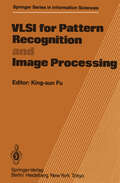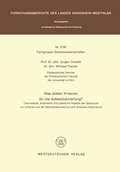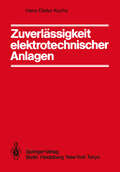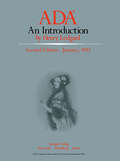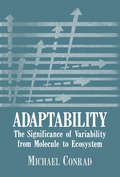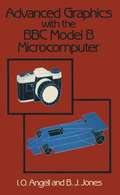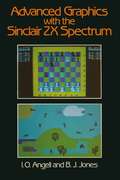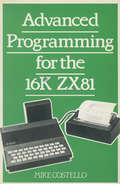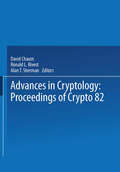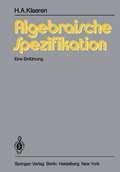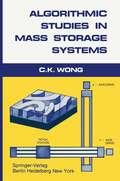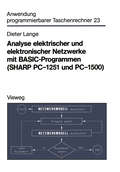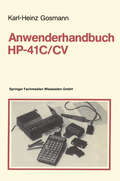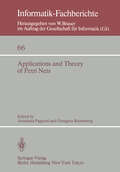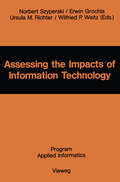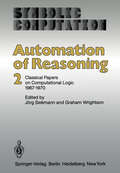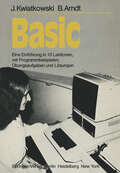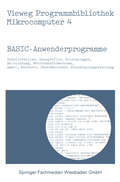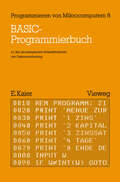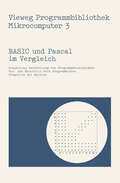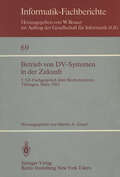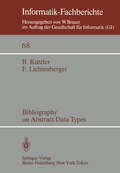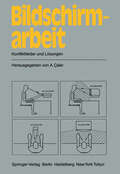- Table View
- List View
Vectorization of Computer Programs with Applications to Computational Fluid Dynamics (Notes on Numerical Fluid Mechanics and Multidisciplinary Design #8)
by Wolfgang GentzschThe scope of the present book is to offer the most efficient tools for the vectorization of serial computer programs. Here, by vectorization we understand the adaptation of computer programs to the special architecture of modern available vector computers to exploit fully their potential, which will often result in remarkable performance improvements. The book is written primarily for users working in the various fields of computational physics, for scientists as well as for programmers running their jobs on a vector computer. The text may, however, also be of value to those who are interested in numerical algorithms. Although the examples discussed in chapter 9 have been taken from Computational Fluid Dynamics, the numerical methods are well-known, and are applied in many fields of Computational Physics. The book is divided into four parts. After a short introduction which outlines the limits of conventional serial computers in contrast to the possibilities offered by the new vector machines, the second part is addressed to the discussion of some main features of existing computer architectures. We restrict ourselves to the vector computers CRAY-1S and CDC-CYBER 205, although, in the meantime, many vector and parallel computers and array processors are available such as DENELCOR's Heterogeneous Element Processor (HEP), ICL's Distributed Array Processor (DAP), SPERRY UNIVAC's Array Processing System (APS), STAR TECHNOLOGIES ST-l00, FLOATING POINT SYSTEMS' Array Processor (FPS), FUJITSU's FACOM VP-l00 and VP-200, HITACHI's Integrated Array Processor (lAP), HITACHI's S 810/10 and S 810/20 and others.
VLSI for Pattern Recognition and Image Processing (Springer Series in Information Sciences #13)
by K. S. FuDuring the past two decades there has been a considerable growth in interest in problems of pattern recognition and image processing (PRIP). This inter est has created an increasing need for methods and techniques for the design of PRIP systems. PRIP involves analysis, classification and interpretation of data. Practical applications of PRIP include character recognition, re mote sensing, analysis of medical signals and images, fingerprint and face identification, target recognition and speech understanding. One difficulty in making PRIP systems practically feasible, and hence, more popularly used, is the requirement of computer time and storage. This situation is particularly serious when the patterns to be analyzed are quite complex. Thus it is of the utmost importance to investigate special comput er architectures and their implementations for PRIP. Since the advent of VLSI technology, it is possible to put thousands of components on one chip. This reduces the cost of processors and increases the processing speed. VLSI algorithms and their implementations have been recently developed for PRIP. This book is intended to document the recent major progress in VLSI system design for PRIP applications.
Was leisten Kriterien für die Aufsatzbeurteilung?: Theoretische, empirische und praktische Aspekte des Gebrauchs von Kriterien und der Mehrfachbeurteilung nach globalem Ersteindruck (Forschungsberichte des Landes Nordrhein-Westfalen #3192)
by Jürgen GrzesikZuverlässigkeit elektrotechnischer Anlagen: Einführung in die Methodik, die Verfahren und ihre Anwendung
by H.-D. KochsADA®: An Introduction
by Henry LedgardIf Charles Babbage is to be regarded as the father of modern day computer technology, then surely the Countess Augusta Ada Lovelace, after whom this new language is named, must be remembered as its midwife. It was she, the daughter of England's poet Lord Byron, who translated the work of the Italian mathematician L.F. Menabrea, attaching her own scientific commentaries on the dissimilarities between the difference engine and the analytical engine. It was Lady Lovelace, the great lady of computers, who delivered the notes and loosely organized writings of Babbage, with her own invaluable amendments, to a world not quite ready to receive them. The Ada language effort has employed hundreds, if not thousands, of minds and a healthy sum of money since its conception. Ada was fostered by the High Order Language Working Group (HOLWG), chartered by the U.S. Department of Defense in January of 1975 with the overall objective of developing a systematic approach to improved use of software by the military. One would think the Pentagon an unlikely foster parent for a new computer language. Regardless of its lineage, the question that begs asking is, of course - Why? The answer is by no means a simple one, but some brief background may help to clarify the matter. At present, the Department of Defense is the largest software consumer on earth, employing roughly 400 different computer languages and dialects. The situation, some have commented, is at best untidy.
Advances in Cryptology: Proceedings of Crypto 82 (Lecture Notes In Computer Science Ser. #304)
by David ChaumAlgorithmic Studies in Mass Storage Systems
by C.K. WongA major technological trend for large database systems has been the introduction of ever-larger mass storage systems. This allows computing centers and business data processing installations to maintain on line their program libraries, less frequently used data files, transaction logs and backup copies under unified system control. Tapes, disks and drums are classical examples of mass storage media. The more recent IBM 3851 Mass Storage Facility, part of the IBM 3850 Mass Storage System, represents a new direction in mass storage development, namely, it is two-dimensional. With the maturity of magnetic bubble technology, more sophisticated, massive, multi-trillion-bit storage systems are not far in the future. While large in capacity, mass storage systems have in general relatively long access times. Since record access probabilities are usually not uniform, various algorithms have been devised to position the records to decrease the average access time. The first two chapters of this book are devoted mainly to such algorithmic studies in linear and two-dimensional mass storage systems. In the third chapter, we view the bubble memory as more than a storage medium. In fact, we discuss different structures where routine operations, such as data rearrangement, sorting, searching, etc., can be done in the memory itself, freeing the CPU for more complicated tasks. The problems discussed in this book are combinatorial in nature.
Analyse elektrischer und elektronischer Netzwerke mit BASIC-Programmen (Anwendung programmierbarer Taschenrechner)
by Dieter LangeApplications and Theory of Petri Nets: Selected Papers from the 3rd European Workshop on Applications and Theory of Petri Nets Varenna, Italy, September 27–30, 1982 (under auspices of AFCET, AICA, GI, and EATCS) (Informatik-Fachberichte #66)
by A. Pagnoni G. RozenbergThis volume presents a selection of papers presented at the 3rd European Workshop on Appl ications and Theory of Petri Nets that took place in Villa Monastero, Varenna (Italy) in the period September 27 - September 30, 1982. The I ist of topics included: nets and related models, mathematical analysis of nets, transformations and morphisms of nets, formal languages and nets, parallel program verification and nets, the pro blem of time in nets, programming languages based on nets, applications to distributed systems, applications to realtime systems, software ~~gineering, hardware design and its implementation, recoverability problems, nets and formal semantics; net tools. The diversity of topics on this list witnesses the fact that the researchers from very different areas presented their contributions and discussed various research problems during the workshop. This interaction of scientists looking at the area of Petri nets from very different points of view makes this series of workshops interesting and worthwi le. The volume documents the progress of the research concerning Petri nets during a one year time from the 2nd European Workshop held in Bad Honnef in 1981. We think that this was a substantial progress indeed. This observation is even more pleasant if one real izes that during the workshop in Varenna we have celebrated 20 years of "existence" of Petri nets (the seminal work by prof. C.A. Petri appeared precisely 20 years ago). We are very proud to present an invited address by prof. C.A. Petri in this volume.
Assessing the Impacts of Information Technology: Hope to escape the negative effects of an Information Society by Research (Program applied informatics)
by Norbert SzyperskiAutomation of Reasoning: 2: Classical Papers on Computational Logic 1967–1970 (Symbolic Computation)
by J. Siekmann G. Wrightson"Kind of crude, but it works, boy, it works!" AZan NeweZZ to Herb Simon, Christmas 1955 In 1954 a computer program produced what appears to be the first computer generated mathematical proof: Written by M. Davis at the Institute of Advanced Studies, USA, it proved a number theoretic theorem in Presburger Arithmetic. Christmas 1955 heralded a computer program which generated the first proofs of some propositions of Principia Mathematica, developed by A. Newell, J. Shaw, and H. Simon at RAND Corporation, USA. In Sweden, H. Prawitz, D. Prawitz, and N. Voghera produced the first general program for the full first order predicate calculus to prove mathematical theorems; their computer proofs were obtained around 1957 and 1958, about the same time that H. Gelernter finished a computer program to prove simple high school geometry theorems. Since the field of computational logic (or automated theorem proving) is emerging from the ivory tower of academic research into real world applications, asserting also a definite place in many university curricula, we feel the time has corne to examine and evaluate its history. The article by Martin Davis in the first of this series of volumes traces the most influential ideas back to the 'prehistory' of early logical thought showing how these ideas influenced the underlying concepts of most early automatic theorem proving programs.
Basic: Eine Einführung in 10 Lektionen mit zahlreichen Programmbeispielen, 95 Übungsaufgaben und deren vollständigen Lösungen (Informationstechnik und Datenverarbeitung)
by J. Kwiatkowski B. ArndtBASIC-Anwenderprogramme (Vieweg-Programmbibliothek Mikrocomputer #4)
by Peter Frahm Werner Hürlimann Helmut Richter Harald Schumny Achim Stößer Wilfried WendtEinführung Von wichtigen internationalen Normungsorganisationen sind Bemühungen bekannt, einen einheitlichen, höheren BASIC-Dialekt zu entwickeln. Nach Verabschiedung solch eines Standards und weltweiter Akzeptierung wäre es erheblich einfacher als heute, BASIC-Programme zwischen Benutzern verschiedener Rechner aus zutauschen. Allerdings können Programme, die den Sprachenumfang des neuen Standards nutzen, nicht auf Systeme übertragen werden, die mit derzeitigen Quasi-Standardversionen arbeiten (wie z.B. Apple-, CBM- oder Tandy-BASIC) . Denn nur wenige Hersteller bieten schon jetzt erweiterte Dialekte, die etwa den Vorstellungen genügen, wie sie beispielsweise vom ANSI (American National Standards Institute) entwickelt wurden. Am ehesten entspricht schon das von Hewlett-Packard für die 80er Systeme entwickelte "Erweitere BASIC" den neuen Festlegungen wie z.B. CALL "Unterprogrammname" Aufruf eines Unterprogramms mit seinem Namen, IF •.. THEN ... ELSE ... zweiseitige Programm verzweigung, PRINT USING ... formatierte Ausgabe. Drei weitere Anweisungsgruppen zeichnen die Programmiersprache BASIC der Systeme wie HP-85 aus: - Graphik-Anweisungen zur Ausgabe von Meß- oder Berechnungs ergebnissen und Beschriftung von Diagrammen, z.B. SCALE, XAXIS, YAXIS, PLOT, DRAW, MOVE, LABEL, PEN - Befehle zur Behandlung von Hardware- und Software Interrupts, z.B. ON ERROR •.• GOSUB (oder GOTO) ON INTR ... ON KEY ..• Einführung ON TIMER •.• - Befehle zur Bedienung des IEC-Busses, z.B. ENTER, OUTPUT, .•• USING ... , Im Beitrag von w. Wendt und H. Schumny werden diese Möglich keiten weitgehend genutzt. Die konkrete Anwendung aus der nuklear-physikalischen Praxis kann sozusagen als Demonstration dafür angesehen werden, was künftige BASIC-Versionen erlauben.
BASIC-Programmierbuch: zu den grundlegenden Ablaufstrukturen der Datenverarbeitung (Programmieren von Mikrocomputern)
by Ekkehard KaierBASIC und Pascal im Vergleich (Vieweg-Programmbibliothek Mikrocomputer #3)
by Harald SchumnyBASIC ist heute so etwas wie eine Standard-Programmiersprache, und für viele private und berufliche Computer-Verwender ist BASIC die als erste gelernte Sprache. Das liegt vor allem an der leichten Erlernbarkeit - selbst Anfänger können bereits nach wenigen Stunden eigene Programme schreiben. Praktische Gründe für die Dominanz von BASIC sind aber auch die Dialogfähigkeit, die interaktives Arbeiten am Computer ermöglicht (Mensch-Maschine-Dialog), und die Tatsache, daß die am meisten verbreiteten Tischcom puter nur BASIC "verstehen". Häufig hört man von erfahrenen Programmierern, BASIC weise eine Reihe ernst zu nehmender Mängel und Nachteile auf, vor allem BASIC erlaubt keine strukturierte Programmierung, verleitet vielmehr zu extensiven Verzweigungen und Verschachtelungen ("Spaghetti"-Stil); es sind nur globale Variablen möglich (nur solche, die für das ganze Programm gelten), lokale Variablen z. B. in Unterprogrammen können nicht definiert werden; symbolische Adressierung ist in der Regel nicht möglich, Variablennamen sind oft viel zu kurz (meist nur 2 Zeichen); das Aneinanderhängen mehrerer Programme (chain, append oder merge) durch Zu laden vom Massenspeicher ist normalerweise nicht möglich; - WHILE-Schleifen, GASE-Strukturen und IF-THEN-ELSE werden nur äußerst selten geboten. Das stimmt .natürlich alles. Es sollte trotzdem immer ehrlich abgewogen werden, ob man auf all diese fehlenden Möglichkeiten nicht auch verzichten kann. Die weite Verbreitung von BASIC läßt den Schluß zu, daß in sehr vielen Anwendungsfällen tatsächlich darauf verzichtet werden kann.
Betrieb von DV-Systemen in der Zukunft: 5. GI-Fachgespräch über Rechenzentren Tübingen, 17./18.März 1983 (Informatik-Fachberichte #69)
by M. A. GraefBibliography on Abstract Data Types (Informatik-Fachberichte #68)
by B. Kutzler F. LichtenbergerSponsored by the "Österr. Fonds zur Förderung der Wissenschaftlichen Forschung", project nr. P4567
Bildschirmarbeit: Konfliktfelder und Lösungen (Informationstechnik und Datenverarbeitung)
by A. E. CakirInhalts}bersicht: Technisierung der Informationsverarbeitung - Gefahr oder Chance? - Technik und Umwelt. - Erfahrungen der Anwender. - Erfahrungen der Sozialpartner. - Normen und Regelungen. - Belastung und Beanspruchung. - Autorenverzeichnis. - Namen- und Sachverzeichnis.


